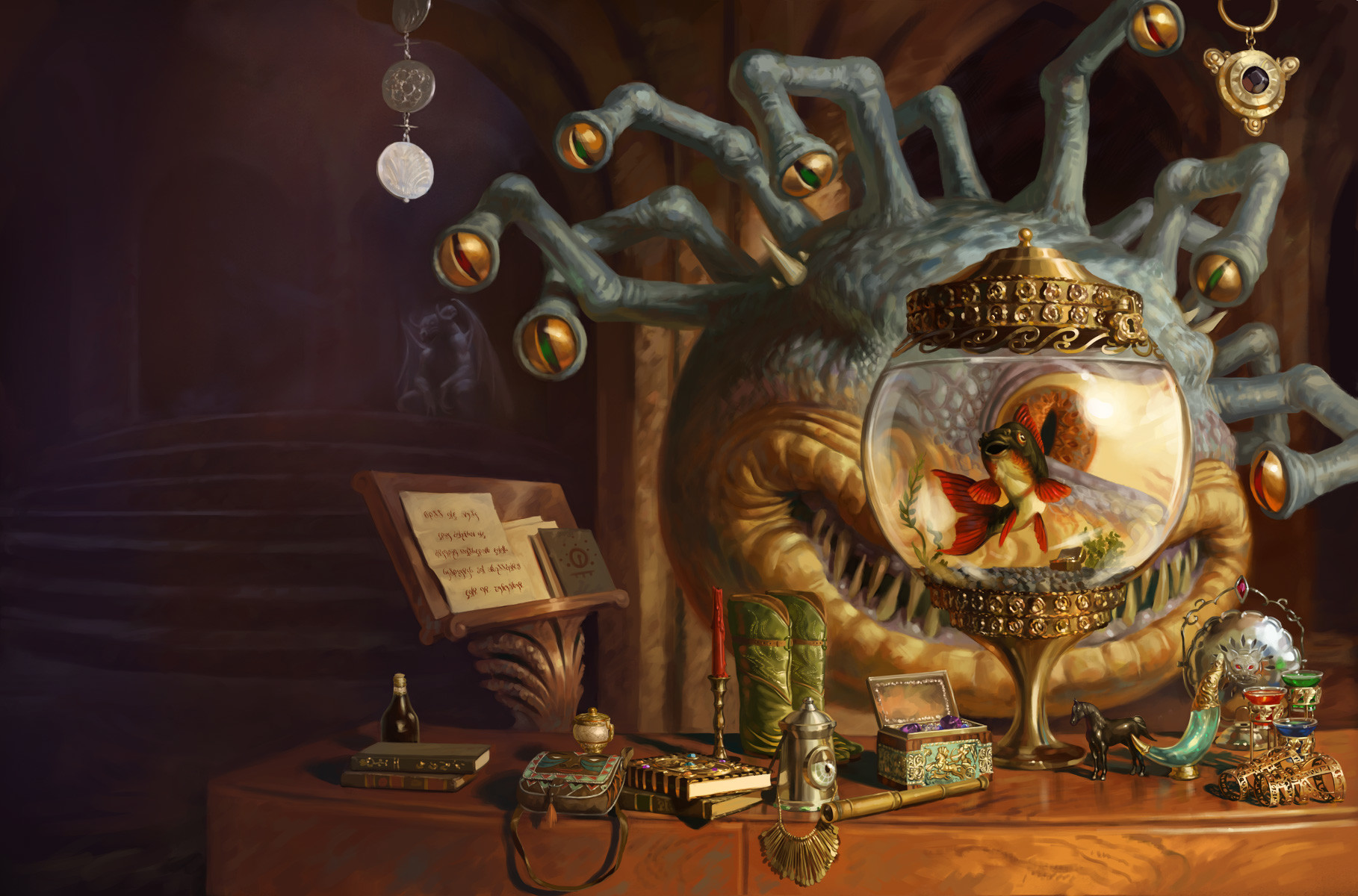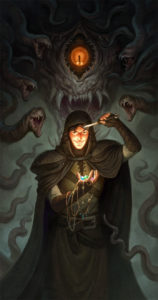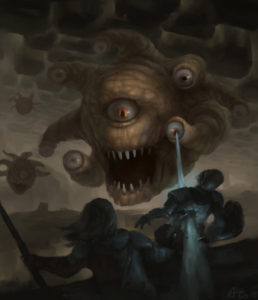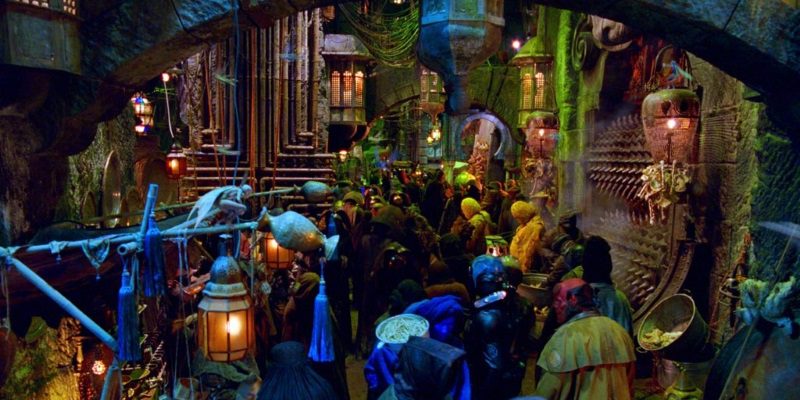Let’s build a Beholder’s Lair + Advice on how to run one
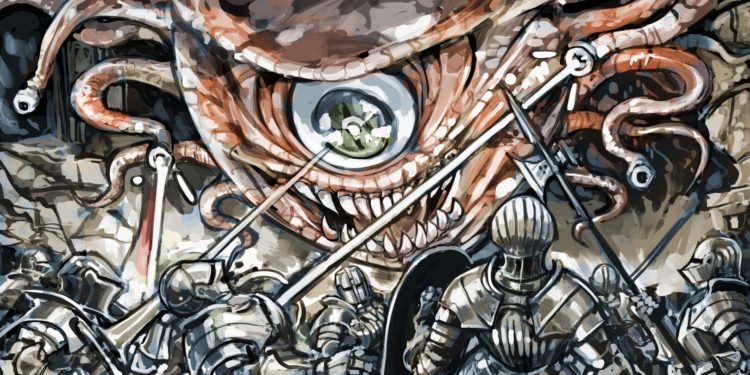
Thumbnail Art by Aaron Ancheta
Continuing my ongoing series on how to run some of the best D&D creatures comes the fan-favorite Beholder (or maybe DM’s favorite, as I think players don’t usually like them as much). They are great monsters full of personality and history in the game, coming from the very first edition of it. Inspired by HP Lovecraft’s stories, beholders are megalomaniac aberrations that come to lead and destroy, while gathering trophies and secrets…
At first, I was planning on creating a full article on how to create a great lair for a beholder, but after giving Volo’s Guide to Monster‘s chapter about it a reread, I can honestly say WotC did a much better job than I would be able to do. Therefore, I’ll do my own spin on it and talk about the things all excellent Beholder confrontations must have to be successful.
Before we begin, however, I wanted to let you know I’ve made other articles from this series before that you may like as well:
- Let’s Build an Aboleth’s Lair + Advice on how to run one
- Let’s Build a Mummy Lord’s Lair + Advice on how to run one
- Rakshasa: Advice on how to run one
The Beholder
Beholders are extremely particular beasts, that differ from most of the other monsters from the game. They believe themselves to be the epitome of perfection. Understand that when I say “themselves” I don’t mean their entire species, but specifically and only them (the single creature). All other beholders are just mere impostors, imperfect beings ready to steal all they have made in their lives. In case you still didn’t notice after reading this, these great one eye beings are also extremely paranoid, to the point of plotting several survival plans going from plan A to plan Z. All of this is accompanied by a huge brain, as beholders are brilliant creatures.
And then there are the eye beams. How to forget them? It’s not only its intellect and paranoia you should be worrying about, but the lasers coming out from its eyes! They come in different forms and sizes, one per stalk coming out from its big, almost spherical body (and there’s 10 of them). These range from rays that cause paralysis, sleep, to others that instantly kill player characters that drop to 0hp, or fully disintegrates them. Oh, but that’s not all! If the beholder likes the player characters enough or considers them great foes, it may decide to use its rays to either charm or petrify their bodies to be used as trophies. As this was not enough, its big central eye creates a big cone in front of it that nullifies all spells and/or magic. When properly used, it becomes the infallible weapon to create spellcasters’ demise (and those carrying magic items).
Let’s first clear some doubts
I’ve run two beholders so far in my time as a DM, one being an evil mastermind that controlled a whole city from the shadows, being foreshadowed since the start of the campaign, and then the Xanathar in Waterdeep Dragon Heist (who shares many similarities). In my time running both creatures, I’ve had to make decisions on the spot when asked about them from my players. Once sessions were over, I would go research if I made the correct choice and I usually would encounter I made some mistake (didn’t prevent them from being unforgettable encounters, though). That’s why I wanted to share my insight with you before we begin to create the perfect lair:
Beholders can control which eye beam to use instead of launching random ones
Yep. Even though the Monster Manual says that the eye rays go to random enemies and have random effects, Volo’s Guide to Monsters indicates that this was only done to simplify the DM’s life in play. You can decide which eye beam goes where, and don’t even need to specify it before making all attacks (you can charm a creature and then redirect the disintegration ray to another PC). Just in case you need a valid example, in Dice Camera Action (a D&D official game stream) Chris Perkins made Xanathar use a Petrification ray, followed by a Disintegration one to instantly eliminate a single creature. It worked and looked both terrifying and badass. I would not use both attacks on a single turn against player characters to leave them a chance of success, but it is entirely possible!
Can you cut eyestalks?
While not legal per sé, I’ve made the mistake of allowing it at my first game, and I did have great results from it. Being able to “kill” or cut out eye stalks is the equivalent of targeting a specific part of the body when attacking. This is not allowed by design in D&D as it would greatly change the game and create the need for hundreds of new calculations (and that IMO is boring and tedious). However, there is a cool aspect for players to cut out one of the many eyestalks, and because the beholder has 10 of them, it is not that big of a loss. I would not suggest using the method I used because it is a bit broken, so I decided to think of another one that might be better for your players: If you are to allow something like this I would only make it possible for players to cut them out with slashing damage-dealing attacks, and only if the PC has advantage on its attack. What’s more, I wouldn’t allow players to choose which eye beam to cut: They would have to roll a d10 to know which one they cut. I imagine the beholder always moving their eyestalks in all directions to see everything at once and fire in all directions, making them difficult to hit, so getting to choose the eyestalk doesn’t seem feasible.
Location
Beholders build or have built their domains usually in caves. They are easy to mold to their like with their disintegration rays, and it is extremely easy to create new tunnels, be it for strategical positioning or escaping. Once we have the place more or less figured out it is fundamental to think about the two things that go hand in hand with beholder lairs: minions and traps.
Minions
From a game designer standpoint, the beholder’s minions are great for many things. First of all, they add a lot of flavor and environmental story to both the beholder and dungeon. Why are they working for the beholder? Which kind of relationship do they have? If the minions are being forced to work for the beholder, they may see a chance of becoming free again by convincing the adventurers to kill the creature. Depending on how scared the minions are from its boss, and how capable they see the player characters, the minions may be able to be convinced to work with the PCs to ambush the beholder, creating a very satisfactory victory.
Goblinoids and Kobolds, as well as Kuo-Toa, Troglodytes and several others intelligent but puny creatures work great as minions. If you do come up with a good enough reason for some other creatures like Matt Mercer did in Season 1 of Critical Role (I won’t talk more about it so as not to spoil it), then go at it. The possibilities are almost endless.
If you want to go for such a paranoid beholder it teaches its minions to work tactically, then go for it! Something like the Tucker’s Kobold’s story can work great in this situation. Have them sound alarms as well to alert their master that something dangerous is coming for it. Have big communication tubes on walls that can be used to send messages to the beholder’s lair. If you are to do this last one, have minions run to inform the beholder how the player characters look and which kinds of abilities they are using.
Traps
The thing here is simple: Beholders hover, so all traps near the ground can be easily avoided, as well as trap rooms by flying through tunnels located on the ceiling for example. Any kind of trap of that style can work great against the players. If some of the minions die by triggering one of them, it’s their fault for not learning the place correctly. No matter, they can be easily replaced.
Volo’s Guide to Monsters, as well as Xanathar’s Guide to Everything and the DMG, have more than enough traps to fill the floor of your dungeon. One that I really like includes filling the ground with spiderwebs to make the PCs have difficult terrain and possibly get restrained. At the same time, a group of kobolds will fire flaming arrows (or alchemist’s fire) from the other side of the room, while giant spiders, spider swarms and phase spiders go for them. Consider adding traps that can impose conditions on the player characters, especially during combat against minions to have them burn their spell slots and resources.
Beholders may create tunnels that travel next to the walls from its dungeon, with small holes to fire eye rays before the players reach the final room.
The final confrontation
As I described earlier, beholders have plots behind plots to deal with whoever tries to kill them. So, in order to make this battle more interesting, is there a way or reason why the beholder could have started to send goons to investigate from afar how the player characters’ usual tactics and abilities are? If so, if the beholder knew the players are after it, it would try to lure them to its lair. By the time the player characters reach it, the beholder will have a great arsenal prepared to defeat them. If the beholder is not aware of the player characters, then it might just have lots of different traps that could be triggered to nullify possible situations.
Creating a battle made to nullify most of the players’ tactics is a bit of an evil move from the DM’s part, but that’s exactly how a beholder would plot the situation. This makes the players think out of the box if they want to survive, creating one extremely memorable encounter (at least that’s how I created the most memorable battle for my players). Getting to understand how to combat the beholder and win the battle works as a puzzle for the players to solve! Don’t try to think of ways the players can solve the situations. Players are always better at it than we from the DM’s chair are. Just try to be kind and permissive when they suggest strategies. We don’t want to kill the player, just make this moment unforgettable. It’s ok for them to become a bit irritated at parts, but it all pays off once they do kill the beholder.
Beholder Tactics
Beholders are the kind of enemies that won’t ever fight until the end. If they see there is no chance to win, they will run away as fast as they can through an exit tunnel. While frustrating, the beholder is the kind of enemy you can only kill by outsmarting it. This may mean the players need to scout the zone and block exits before confronting it or catch it by surprise in some way. However, being the megalomaniac beings they are, beholders might get too confident, giving the players an opportunity to annihilate it before it can escape. In other words, players should not be able to kill the beholder on their first encounter with it. If they do, hurray for them, but we should try to avoid that if possible.
Have the beholder hover at all times, staying out from the player character’s reach. If they can, Beholders will try to stay between 95-120ft away from the players, to be able to stay out of reach from both spells and melee and most ranged attacks. Both its rays and antimagic field have an extremely impressive reach, so they can stay distant without any problem. So yes, you might need a pretty big lair.
The Beholder has 17 in the Intelligence ability score, and a passive perception of 22, meaning it can easily understand the player characters’ usual combat maneuvers, as well as how strong, dexterous, perceptive, etc they may be. In other words, it would make sense for the beholder to fire eye beams it would think the PC is weak at judging by their looks. If the beholder has been researching the player characters for some time, the beholder will most probably be right with its assertions. What does this mean? The beholder would not launch a Petrification ray (which requires a Dexterity Saving Throw) to the rogue-looking player character… It would probably fire it against the heavy-armored one.
More traps!
The beholder needs to have many traps prepared in its lair to remain victorious. I will list some in here, but feel free to add your own to nullify some of the player characters’ abilities:
- Have craters placed in the room that throw out such a dense gas that it stays near the ground, covering the entire room. All fire that goes near the gas makes all standing inside of it receive the fire damage as well as the target. If you want to be a bit harsher, make it so that PCs have to make DC13 Constitution Saving Throws at the beginning of their turns or become poisoned. The craters can be filled with something to prevent them from leaking the gas. Player characters need to do this with all of them to make the gas disappear.
- A false ceiling can be destroyed by the beholder to let a Huge gelatinous cube fall over the players to trap them
- Some minions could be in small jails that cling from chains to the ceiling. Breaking them frees the minion to join the battle. Player characters may be able to push jails towards the beholder, or swing from it for some great attack moves.
- A water tank is located at someplace in the lair. Attacking it causes the tank to wet all creatures in a 30ft area from it. Wet creatures receive 1d10 lightning damage when casting lightning spells.
- A false floor could be located in the middle of the room, that can only be seen with a DC16 Wisdom (Perception) check, or if the player character’s passive perception is greater than the number. Stepping on it requires the creature to make a DC15 Dexterity Saving Throw or fall 30ft to quicksand on the bottom (rules to handle quicksand can be found in p110 from the DMG).
- Several petrified people and monsters could be placed by the side of the chamber. The Beholder can use its telekinetic ray to hurl them towards the players. Consider having some petrified ogres to use as boulders. What’s more, having innocent petrified people being thrown at the players and getting broken will create a sense of urgency in the battle. They need to save those people (maybe have a known NPC in the mix)
- Have a Mirror of Life Trapping on one corner of the room, covered by a blanket. The beholder can use its telekinetic ray to lift the blanket and trap player characters in front of it. The only way for a character to get out is by using the command word, that only the beholder knows (some minion may have overheard this command word). Make the beholder taunt the players by saying that they can’t kill him if they want to save their friend.
- Place a big boulder (or a huge petrified creature) hanging by a rope on top of the entrance to the lair. As soon as they are all in (or even better: once only a few are in), have the beholder break the rope with some ray, blocking the only entry (besides the escape tunnel in case the beholder needs it)
Treasure room
Last but not least, a great beholder might consider building two treasure rooms, one of them being a trap. If the player characters get too greedy and go look for magic items while in combat, they may end up finding their demise. If not, the beholder is resentful enough to want whoever killed it dead as well.
Place two treasure rooms, one of them with all the treasure a beholder might not consider useful (weapons, armor, gold…), and the other one with all the things the beholder does truly care about and can use or look at (rings, capes, paintings, trophies…). Some of the items in the first treasure room are placed on a pressed pressure plate (while pressured it looks as if it was part of the ground). This can only be seen with a successful DC17 Wisdom (Perception) check. If an item were to be lifted from that treasure room, the room would collapse over the player characters. Because the beholder does not really care about those items, it didn’t really care if they were to accidentally break.
Conclusion
It took me some time to think of things that haven’t already been said about the beholder. However, being such a great creature to use, it ended up being worth the effort. I hope you find here some things to create a very memorable battle. If you do think of some other tips to give new players who want to play a beholder, be sure to write them down on the comment section below!
Which monster would you like me to research and create a lair/tactics for? Be sure to add it in the comments below, as I love making these kinds of articles
If you liked this
Do you love monsters so much you would love to be able to play one as a player character, at least for a one-shot? Take a look at this half-vampire, vampire, and ghost subraces! [Note: They are made on purpose to not be very balanced, the reasoning appearing in the article]

